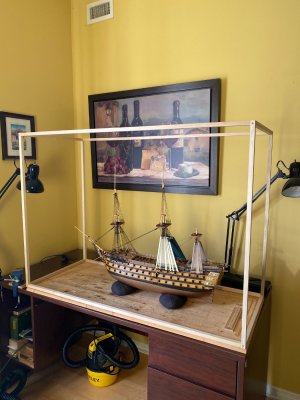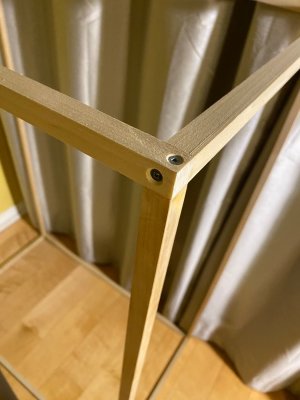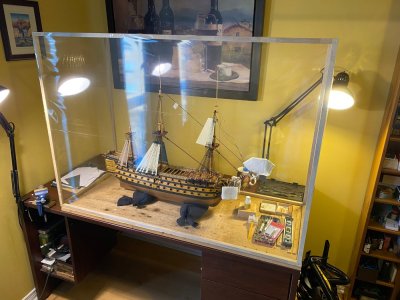Per you suggestion I have decided to give it ago and construct my own case, I went through my wood pile and found a very nice straight 3/4" x 11' walnut trim. It's It has a routed profile on one side and it's 2 1/4" on the flat and 2 7/16" wide total. I have all the tools but since I have not used them for quite some time I'm going to draw it out and get started cutting and fitting some pine I have.A few thoughts in response. My own opinions:
I always consider the archival qualities of any material I put into a model. I follow the Specifications for Construction of Exhibition Models of U.S. Naval Vessels issued by the U.S. Navy's Sea Systems Command, Curator of Models: https://www.navsea.navy.mil/Home/Wa...ications-for-Building-Exhibition-Ship-Models/ These specifications are the "state of the art" for fine ship models. Most serious modelers follow them as much as possible and most museums and serious collectors demand them. Some deviation is possible but modern synthetic materials, particularly adhesives and coatings, should be avoided not simply because they may not meet the threshold hundred-year archival requirement, but also because the Navy standards produce a model which, if and when maintenance or restoration is required, will be amenable to disassembly for repair as needed with minimal impact to the rest of the model. For this reason, I would not use anything other than shellac on rigging cordage.
Like most modelers working for over fifty years in the game now, I once considered waxing rigging cordage to be mandatory. I no longer do. Bees wax is quite acidic for one thing, and for another, it seems to attract and hold dust like a magnet does iron filings. Microcrystaline "museum wax" is ph neutral but still poses the dust problem and is more difficult to apply to the cordage than bee's wax. The modern synthetic and synthetic/natural blend thread at this point seems sufficiently archival and doesn't present the problem of "fuzz" that natural threads often do. Linen thread, once the standard, is no longer readily available and, for modeling purposes, relatively extinct. I now defer to the opinion of the conservators at a number of major museums who are specifying Gutermann Mara polyester thread for rigging cordage. There are different grades of this stuff for the professional and the home sewing markets. Spools of the quantities and the colors one needs for laying up their own scale cordage can be ordered online from Wawak tailoring supply house: https://www.blog.wawak.com/post/gutermann-mara-thread-color-chart
Based on my own experience, which is to say my assessment may be biased by my own lack of skill, I would not consider an acrylic or polycarbonate case for a ship model. I have found getting a perfect joint glued to construct a plastic case to be near impossible unless one is a trained professional with the shop equipment to get the job done right. Acrylic and polycarbonate sheet is a rather expensive material as well and some of it isn't scratch proof. Plastics will outgas to some degree and outgassing can create an environment in a case which will promote degradation of the model. While admittedly a matter of personal taste, I've never thought an unframed case benefits the aesthetics of a model's presentation. I feel this is particularly true with period ship models. There's just something "solid and traditional" about a wooden framed display case.
Again, it's just my own personal opinion, but I've always found built cases to be outrageously overpriced for what they are. I suppose the high prices are an indication of what the market will bear, more than anything else, and the challenges posed by shipping the finished product, of course. Anyone who can build a ship model, or even assemble a ship model kit, ought to have no problem building a case for it. In terms of tools, all that is required is a table saw, a means of precisely cutting forty-five-degree angles and a means of clamping the mitered joints for assembly. The glazing for a case is easily held in a groove cut in the frame pieces with the table saw. If one doesn't have a table saw, it should be easy enough to find a friend who does or a local junior college manual arts class shop where a table saw can be accessed. The building of a case couldn't be simpler in terms of woodworking skills. There must be any number of practicums online for case building. It's simple enough that one doesn't even need plans and can just "wing it" freehand, although a few measurement notes never hurt!On the other hand, there's nothing preventing building a case that does credit to the fine custom furniture maker's art.
-

Win a Free Custom Engraved Brass Coin!!!
As a way to introduce our brass coins to the community, we will raffle off a free coin during the month of August. Follow link ABOVE for instructions for entering.
You are using an out of date browser. It may not display this or other websites correctly.
You should upgrade or use an alternative browser.
You should upgrade or use an alternative browser.
a friend of mine on long island is going to throw out his salt water fish tank. its 48"long x 24" wide and 28" deep.
if you are local n want to pick it up?
the glass is 5/16" thick.
let me know soon?
if you are local n want to pick it up?
the glass is 5/16" thick.
let me know soon?
Paul I live in Kansas City so wouldn't work. Thanksa friend of mine on long island is going to throw out his salt water fish tank. its 48"long x 24" wide and 28" deep.
if you are local n want to pick it up?
the glass is 5/16" thick.
let me know soon?
Just a caution on adding shellac to rigging. I have a model built by an ancestor about 150 years ago. About 100 years ago, a friend of the family re-rigged it. When he finished, he treated the lines with shellac, which caused them to tighten up and break quite a few parts. He was so discouraged that it has remained that way since. I got into ship modeling to learn enough skills to feel confident about restoring it, but 10 years in I am still learning and will probably never touch it.
View attachment 503888
Wow! That's a really unfortunate result. I've never seen nor heard of it before. There are perhaps too many unknowns to identify the cause for certain. That said, fifty-year-old thread a hundred years ago may not have been all that strong to begin with and we have no way of knowing the environmental conditions in which the model was kept for the first fifty years. It is theoretically possible for laid up cordage to shrink in length, because the swelling resulting from absorption of the alcohol solvent in shellac can cause a laid rope to shorten as the twisted fibers swell against each other, but alcohol evaporates so quickly and the residual shellac solids in thinned shellac are rather minimal and solidify progressively as the alcohol evaporates, so one would expect any tightening of the rigging tension to be negligible. The thickness or "cut" of the shellac applied may have something to do with it, though. The reported cause is even more mysterious since modelers have long treated rigging with liquids similar to shellac, such as PVA adhesive thinned with water and clear fingernail lacquer thinned with acetone, and I've never heard of similar tightening from those liquids.
While it may well be a tedious process, the good news is that shellac is readily soluble in denatured alcohol. Taking a cotton ball or swab or bit of toweling soaked in denatured alcohol and wiping down the threads should dissolve the shellac and permit a goodly portion of it to be removed. This treatment may permit the threads to return to their intended lengths, relieving at least enough tension to straighten things out.
In any event, one hundred- and fifty-year-old thread which has probably seen more than its share of UV radiation, is almost certainly past its prime and a total re-rigging is probably in order in any event. The model appears of sufficiently high quality and surely of sufficient antiquity that a sensitive conservation is warranted.
Linen and silk are still available, at reasonable cost, in many colors, at Bookbinding supply houses. Bookbinders have been dealing with these issues for many centuries. Try https://www.talasonline.com/fabrics-and-leather/threads-and-tapes. I have never had a problem with Talas.
Yes, I am familiar with bookbinding supply houses as a source of white linen thread, among other things. The linen thread this company offers on their web site comes in a variety of sizes, but the two smaller sizes appear to be as much as would be useful to anybody working in 148 or larger scale, but unless one is just using thread "off the spool," rather than laying up their own scale cordage, only the two smallest sizes appear suitable for modeling use. (The diameter of laid up rope will be three time the siz oof a single strand of thread. The French linen thread looks to be pretty good, but I can't tell from the photos whether it is free of "lumps and bumps" and is of the highest quality, which is required for laying up scale rope.
Yes, I am familiar with bookbinding supply houses as a source of white linen thread, among other things. The linen thread this company offers on their web site comes in a variety of sizes, but the two smaller sizes appear to be as much as would be useful to anybody working in 148 or larger scale, but unless one is just using thread "off the spool," rather than laying up their own scale cordage, only the two smallest sizes appear suitable for modeling use. (The diameter of laid up rope will be three time the siz oof a single strand of thread. The French linen thread looks to be pretty good, but I can't tell from the photos whether it is free of "lumps and bumps" and is of the highest quality, which is required for laying up scale rope.
can you post a link to the linen supply?
- Joined
- Apr 30, 2018
- Messages
- 117
- Points
- 88

For anyone interested in locations to buy linen thread, I purchased a spool of it for around $15 at a shoe repair shop. I've also noticed it for sale in the book binding sections at an art supply shop, also reasonably priced and in various thicknesses.
Neat looking model and has a case too. It's a shame to let that go unrepaired. Don't wait till you can't see the parts , do it now.Just a caution on adding shellac to rigging. I have a model built by an ancestor about 150 years ago. About 100 years ago, a friend of the family re-rigged it. When he finished, he treated the lines with shellac, which caused them to tighten up and break quite a few parts. He was so discouraged that it has remained that way since. I got into ship modeling to learn enough skills to feel confident about restoring it, but 10 years in I am still learning and will probably never touch it.
View attachment 503888
can you post a link to the linen supply?
Here it is again. https://www.talasonline.com/fabrics-and-leather/threads-and-tapes The two smallest sizes of linen thread may be suitable for use as rigging and perhaps larger sizes if one is only going to use the thread alone for rigging material. If, however, as is usually the case in at least 1:96 and larger scales, laid scale rope will be used, anything laid up from available sizes beyond the smallest two will probably yield scale rope that is over sized for the purposes intended.
wonderful, thanks. yes at smaller scale, finding a suitable size is always a problem and most times a single thread works just fine as is and even that has the problem of scaling for multi uses on the same ship.. it would be nice to find smaller gages to run on a rope walk.
what about hemp threads? i do see some at hobby stores. its not very thin but may serve in some places for decorative use.
what about hemp threads? i do see some at hobby stores. its not very thin but may serve in some places for decorative use.
wonderful, thanks. yes at smaller scale, finding a suitable size is always a problem and most times a single thread works just fine as is and even that has the problem of scaling for multi uses on the same ship.. it would be nice to find smaller gages to run on a rope walk.
what about hemp threads? i do see some at hobby stores. its not very thin but may serve in some places for decorative use.
For all practical purposes, hemp and flax (linen) share the same material qualities and when processed in the same fashion are only distinguishable by laboratory analysis.
Paul I live in Kansas City so wouldn't work. Thanks
Hi, Roger, could you please show some detailed pictures of cases you built? I am specifically interested in how all cones together and looks like. What is the average cost? I recently built a frame over my model trying to make it as cheap as I can. I used 5/8 x 5/8 dowels from Home depot and wrapping clear plastic sheet. I was able to make it within 65 USD.My glass cases use single strength glass. I have found ordinary window glass to work well. The glass is set in a wooden frame built from cabinet grade lumber. I have used cherry, teak, mahogany, and native black walnut (my favorite) the frame pieces are grooved with a table saw. The blade cuts a groove that fits the glass. I use epoxy to glue the frame together.







